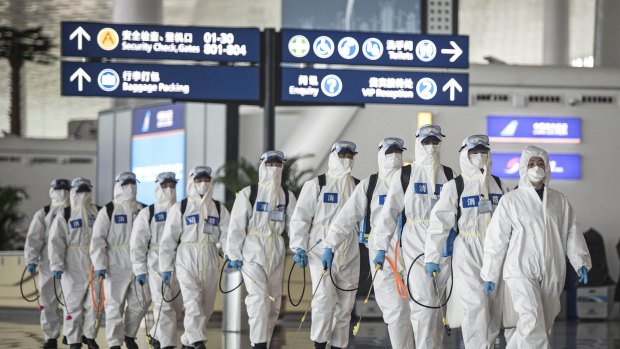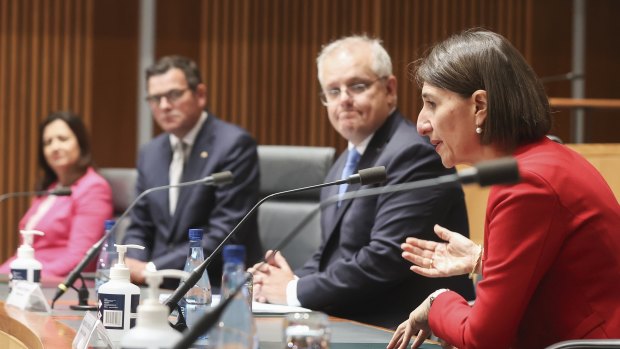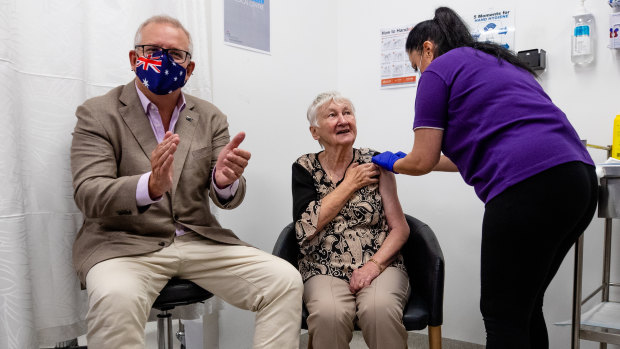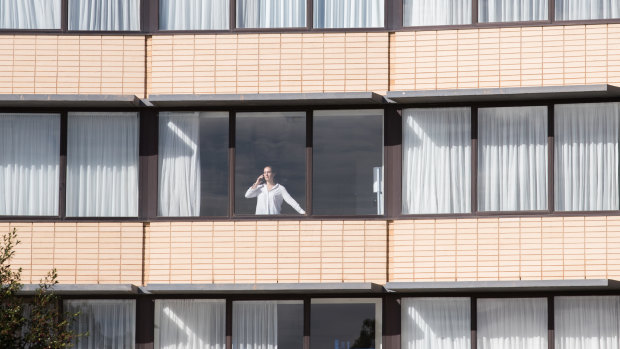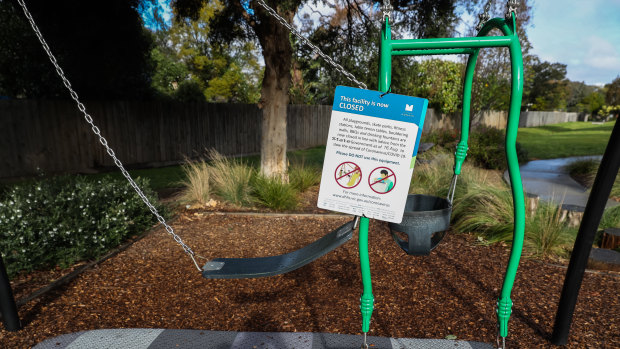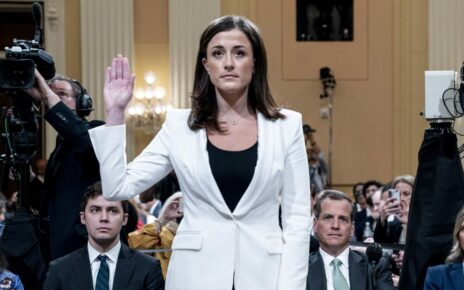Save articles for later
Add articles to your saved list and come back to them any time.
A three-person panel will investigate the Commonwealth’s response to the COVID pandemic. Here are six issues it must probe ahead of the next killer bug.
Pandemic preparedness
Within weeks of COVID-19 spawning in China, it became clear the world’s health authorities had been caught unaware and unprepared.
That was also the case in Australia, where within days of the first cases being confirmed on local soil in late January it became clear the country was already running out of masks because stocks had run down after summer bushfires.
Months later, as hospitals around the country struggled to secure enough masks, gowns and gloves, it emerged that those vital items of personal protective equipment were not among the items put aside in the national medical stockpile for such a crisis.
Government workers in China’s Hubei Province in April 2020.Credit: Getty
But even as far into the pandemic as January last year, Australia was struggling with shortages – this time, of rapid antigen tests.
Infectious diseases paediatrician Professor Robert Booy said Australia needed to make sure its supply chains worked “quicker and better”.
“We need to continue to be the smart country, where we can ensure the production of therapeutic drugs, vaccines, non-pharmaceutical measures such as hand soaps and masks, and ventilators,” Booy said.
National co-ordination and lockdowns
Then NSW premier Gladys Berejiklian (right) addresses a national cabinet meeting in December 2020, alongside Scott Morrison, Daniel Andrews and Annastacia Palaszczuk.Credit: Alex Ellinghausen
Former prime minister Scott Morrison launched the national cabinet – a regular meeting of the prime minister, state premiers, and territory chief ministers – and it became a cornerstone of Australia’s pandemic co-ordination.
Some decisions were made without much tension, including when the prime minister and premiers announced changes to isolation lengths and the way out of the pandemic.
But disagreements sometimes occurred, including over vaccine procurement and the harshness of lockdowns.
Epidemiologist Catherine Bennett, who is one of three experts leading the inquiry, said the national cabinet was one of the most important legacies of the pandemic.
She said the inquiry would probe “how we work as a federation in crisis situations”.
Vaccine procurement and rollout
Then prime minister Scott Morrison with Jane Malysiak, the first person to receive a COVID-19 vaccine in Australia.Credit: Edwina Pickles
Australia’s COVID-19 vaccine rollout began on February 21, 2021 in Sydney with the vaccination of aged care resident Jane Malysiak.
Morrison, who also got vaccinated that day, hailed it as a “big game changer”.
But the national vaccination rollout was soon beset by problems, from rare but serious side effects linked to the AstraZeneca vaccine to supply delays that many blamed on the Morrison government.
Border closures and quarantine
A woman in Melbourne’s hotel quarantine program in 2021.Credit: Jason South
Border closures such as the long-running WA iron wall and the occasional ring of steel between Victoria and NSW were fiercely debated at the time. However, it is unclear if the inquiry will examine the issue because the closures were enacted by state governments, whose unilateral decisions have been controversially excluded from the scope of the review.
When in opposition, Anthony Albanese became fond of saying the Morrison government had just “two jobs”, and he claimed the government had failed at both. Those tasks were handling vaccine purchasing and quarantine.
The basis of this claim was that in the Australian Constitution, the federal government has responsibility for the task of quarantine.
Despite this, state governments – as they did on many other matters – acted solo, with mixed results in keeping COVID-19 out of the community.
The inquiry will likely examine how Australia manages the task of isolating sick people, as well as the rules around allowing stranded Australians back into the country when a new bug is spreading around the globe.
School closures
Melbourne’s playgrounds were closed for a brief period.Credit: Getty
Children in their formative years were hit hard by the pandemic. While it emerged they were least affected by the virus itself, children were subject to long periods of school closures.
Professor Booy said the experience of children warranted investigation.
“We need to think more carefully about closing schools. There were impacts on children’s education and mental health, and long-term effects,” he said.
JobKeeper, superannuation raiding and financial stimulus
People queue up at a Centrelink office in Sydney in March 2020.Credit: Janie Barrett
The border closures, lockdowns and spread of COVID-19 cases battered Australia’s economy, as evidenced by now-famous photographs of long queues outside Centrelink offices in the pandemic’s early days.
The federal government’s solution in March 2020 was JobKeeper – a $1500 per fortnight payment to employees of companies expecting at least a 30 per cent fall in turnover.
The $90 billion scheme saved an estimated 800,000 jobs, according to the Morrison government, but millions of dollars also went to profitable firms such as Harvey Norman.
A Treasury review in 2021 found up to $27 billion went to businesses that did not suffer as much as they feared, and the department set up another review in June this year to determine whether it got value for money from the scheme.
In total, the federal government spent $291 billion in direct economic support for the pandemic by May 2021, fuelling the Commonwealth’s debt level.
The inquiry’s economic expert, Dr Angela Jackson, will no doubt look closely at the government’s fiscal response.
Cut through the noise of federal politics with news, views and expert analysis from Jacqueline Maley. Subscribers can sign up to our weekly Inside Politics newsletter here.
Most Viewed in Politics
From our partners
Source: Read Full Article
